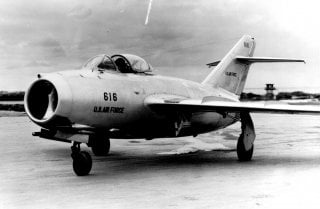Operation Moolah: The Secret Plan to Get a Russian Fighter Jet out of North Korea
Just the kind of plan an American capitalist would think of.
Korea, 1953. The United States’ latest fighter jet, the F-86 Sabre is getting blown out of the sky. Despite being touted as the most advanced fighter in the world, American pilots can’t keep up. They’re being outgunned and outmaneuvered by a pipsqueak of a jet—the MiG-15.
The Russian Connection
In 1950, the MiG-15 appeared in the skies over Korea. The MiG-15 preformed better than the F-86 did in a dogfight—it could accelerate faster and was more maneuverable when flying over 10,000 feet, or about 3,000 meters. In addition, the little jet had two 23 millimeters guns, and one massive 37 millimeter cannon that wreaked havoc on the F-86 and the bombers they were escorting.
When the MiG-15 appeared on the Korean Peninsula, there was rampant speculation that the Soviet Union had donated airframes—and Russian pilots—to the North Korean communist cause.
These rumors were not unfounded. Some United Nations prisoners of war told stories of contact with Russian pilots during their time in captivity. Some American fighter pilots had also heard chatter between MiG-15 pilots while in the air—in Russian.
In any case, the United Nations, and the U.S. Air Force especially, were hurting. What they needed was to study an enemy MiG-15 in person to get a better feel for the jet and its capabilities.
Operation Moolah
On the 26th and 27th of April 1953, a bomber group flew over targets in North Korea. The bombers carried a unique payload. Rather than bombs, they carried over a million leaflets that were written in Russian, Chinese, and Korean. They offered a “monetary reward to any Communist pilot who would deliver a MiG-15 or other Soviet-made jet plane to the UNC forces in Korea.”
The first pilot to defect with a Soviet jet was promised a $50,000 bonus, though all defectors with jets were to be given a base reward of “$50,000, political asylum, resettlement in a non-communist country, and anonymity if desired.” The U.S. Air Force primarily hoped to get their hands on a MiG-15, and secondarily hoped that their reward offer would sow division between the tri-national group of pilots that were downing American jets.
It worked…somewhat.
Bombs Away
After the leaflet dispersal, MiG-15s were scarce. One American general wrote that “the Red’s first reaction to it was to ground all MiGs for eight days. It might have been because of the weather, or because they wanted time to screen out the politically unreliable pilots. Most likely it was the latter,” though bad weather was certainly a factor.
According to some sources, the Russians may have had more to fear from Operation Moolah than the Chinese or Koreans did. After the leaflet drops, a radio jammer somewhere in North Korea jammed the radio component of the Moolah campaign—but just in Russian. The Koreans quickly caught on though.
On May 27th, Kim Il-sung sent a message to the North Korean Air Force, encouraging pilots to be strong in the face of the enemy and do their utmost to protect their airframes.
Defector
On September 21st of the same year, No Kum-sok flew his MiG-15 from an airbase outside of Pyongyang to South Korea. No was hustled to Seoul, and MiG-15 was transported out of the country. He claimed to have not heard of the reward.
Though Operation Moolah was ultimately unsuccessful, No’s defection out of disgust with the North Korean communist regime gave the United States a great deal of information of Soviet jet designs.
Interestingly, No said that rather than a financial reward, which North Korean and Chinese pilots would have difficulty with conceptually, citizenship and freedom would have appealed more. Either way, American pilots suffered fewer losses after No’s defection.
Caleb Larson holds a Master of Public Policy degree from the Willy Brandt School of Public Policy. He lives in Berlin and writes on U.S. and Russian foreign and defense policy, German politics, and culture.
Image: Wikimedia.

